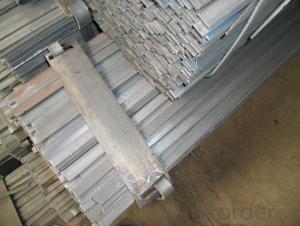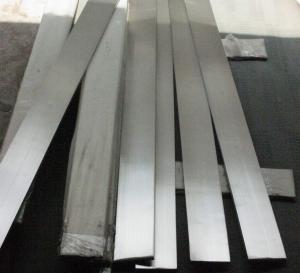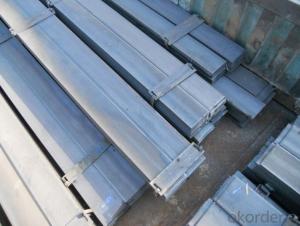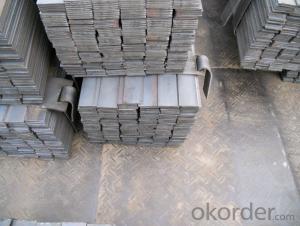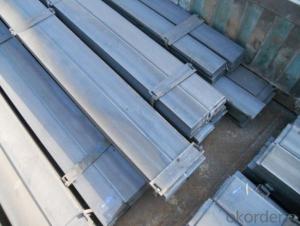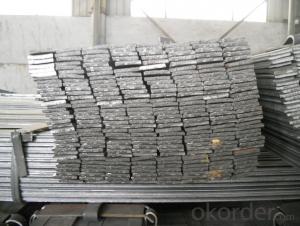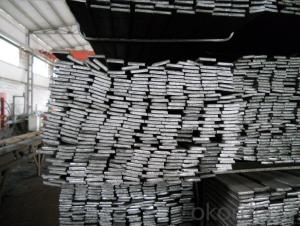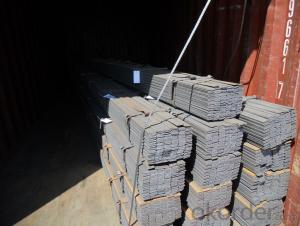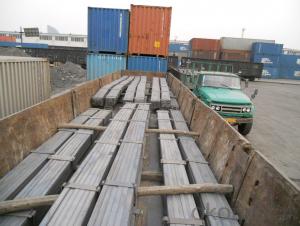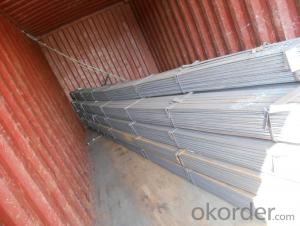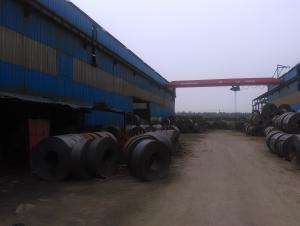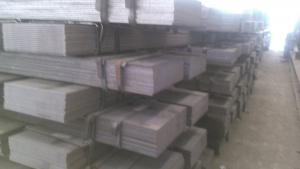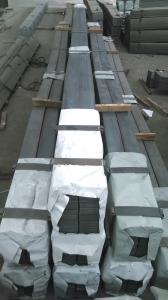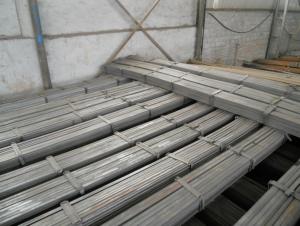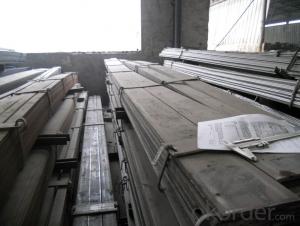GB Standard Steel Flat Bar with High Quality 40mm
- Loading Port:
- Tianjin
- Payment Terms:
- TT OR LC
- Min Order Qty:
- 25 m.t
- Supply Capability:
- 15000 m.t/month
OKorder Service Pledge
OKorder Financial Service
You Might Also Like
Product Description of GB Standard Steel Flat Bar with High Quality 40mm:
Specification of GB Standard Steel Flat Bar with High Quality 40mm:
-Standard: GB
-Material: Q235
-Length: 6m, 12m
-Size:
| Size(mm) | Mass(Kg/m) |
| 40*5 | 1.57 |
| 40*8 | 2.51 |
| 40*10 | 3.14 |
Package & Delivery of GB Standard Steel Flat Bar with High Quality 40mm:
1.The steel flat bars will be packed in bundle with steel wire at each end of every bundle and color marking in order to help the customer to recognize his goods more easily at sight.
2. And the steel flat bars could be loaded into 20ft or 40ft container, or by bulk cargo. If the weight of each bundle reaches more than 3.5 mt, the loading by break bulk cargo should be choosed. When the weight of each bundle reaches less than 3mt, the loading by container should be choosed.
3.As for the transportaion from mill to loading port, the truck will be usually used. And the maximum quantity for each truck is 40mt.
4.All in all, we could do in accordance with customer's request.
FAQ:
Q1: Why buy Materials & Equipment from OKorder.com?
A1: All products offered by OKorder.com are carefully selected from China's most reliable manufacturing enterprises. Through its ISO certifications, OKorder.com adheres to the highest standards and a commitment to supply chain safety and customer satisfaction.
Q2: How do we guarantee the quality of our products?
A2: We have established an advanced quality management system which conducts strict quality tests at every step, from raw materials to the final product. At the same time, we provide extensive follow-up service assurances as required.
Q3: How soon can we receive the product after purchase?
A3: Within three days of placing an order, we will arrange production. The shipping date is dependent upon the quatity, how many sizes you want and the plan of production, but is typically 1 month to 2 month days from the beginning of production.
Images of GB Standard Steel Flat Bar with High Quality 40mm:
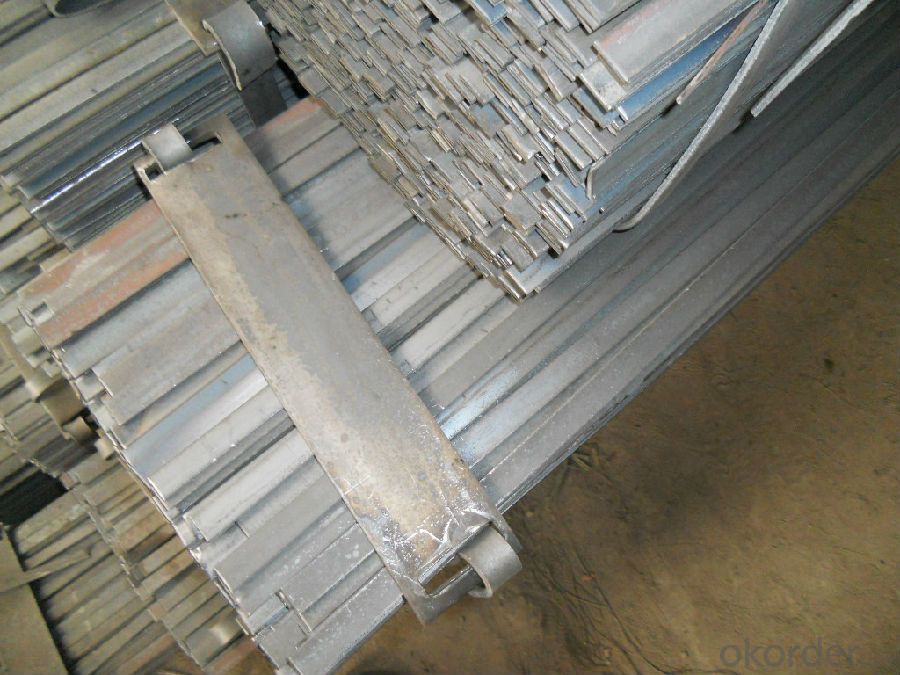
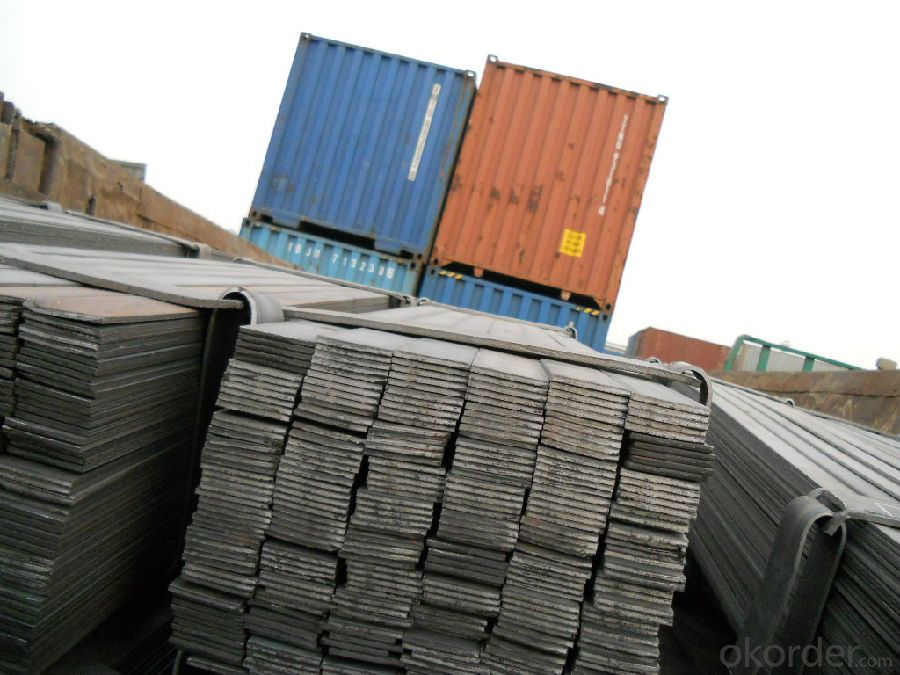
*If you would like to get our price, please inform us the size, standard/material and quantity. Thank you very much for your attention.
- Q: How is the thickness of a steel flat bar measured?
- The thickness of a steel flat bar is typically measured using a caliper or a micrometer. These measuring tools are designed to accurately determine the thickness of objects by measuring the distance between two opposite sides. To measure the thickness of a steel flat bar, one would simply place the caliper or micrometer jaws on either side of the bar and tighten them until they firmly grip the surface. The measurement can then be read from the tool's display or scale, providing an accurate reading of the bar's thickness. It is important to ensure that the measuring tool is properly calibrated and that the jaws are perpendicular to the surface of the bar to obtain an accurate measurement.
- Q: Can steel flat bars be used for support beams or columns?
- Steel flat bars can serve as support beams or columns in construction due to their strength and durability. Their ability to provide structural support and stability makes them commonly used in the industry. Nonetheless, it is crucial to assess the project's specific requirements and load-bearing capabilities before utilizing steel flat bars for such purposes. Seeking advice from a structural engineer or construction professional is advised to guarantee the suitability of the steel flat bars for the intended use and compliance with safety standards.
- Q: How do steel flat bars compare to other types of steel bars?
- Steel flat bars are a versatile and widely used type of steel bar that have several advantages over other types of steel bars. Firstly, steel flat bars offer a larger surface area compared to other types of bars, such as round bars or square bars. This larger surface area makes steel flat bars ideal for applications where strength and stability are required, such as in construction or industrial projects. The increased surface area also allows for better distribution of weight and stress, making steel flat bars more resistant to bending or warping under heavy loads. Additionally, steel flat bars are easy to fabricate and shape, making them suitable for a wide range of applications. They can be easily cut, drilled, welded, or machined to meet specific project requirements. This versatility makes steel flat bars a popular choice among manufacturers, fabricators, and DIY enthusiasts. Furthermore, steel flat bars have excellent strength and durability properties. They are typically made from carbon steel, which provides high tensile strength and good overall toughness. This allows steel flat bars to withstand heavy loads and resist deformation better than other types of bars. Steel flat bars also have a high resistance to corrosion, which makes them suitable for outdoor applications or in environments where they may be exposed to moisture or chemicals. In terms of cost, steel flat bars are generally more affordable compared to other types of steel bars, such as stainless steel or alloy steel bars. This makes them a cost-effective option for various projects, especially in industries that require large quantities of steel bars. In summary, steel flat bars offer several advantages over other types of steel bars, including a larger surface area, ease of fabrication, excellent strength and durability, resistance to corrosion, and affordability. These qualities make steel flat bars a popular choice in a wide range of applications, from construction and manufacturing to DIY projects.
- Q: How do steel flat bars compare to other types of steel profiles?
- Steel flat bars have several advantages over other types of steel profiles. Firstly, their flat shape makes them ideal for use in applications where strength and stability are important, such as in construction and manufacturing. The flat surface also allows for easy attachment and welding, making them versatile and easy to work with. Compared to other steel profiles, such as round bars or square bars, flat bars have a larger surface area, which can contribute to better load distribution. This makes them suitable for applications that require even weight distribution, such as in bridges or platforms. Additionally, steel flat bars have a uniform thickness throughout their length, unlike other profiles that may have varying thicknesses. This uniformity ensures consistent strength and structural integrity, making flat bars reliable and predictable in their performance. Furthermore, steel flat bars are often more cost-effective than other profiles due to their simpler manufacturing process. They can be produced in large quantities and require less machining, resulting in lower production costs. This affordability makes them a popular choice for various industries. However, it is important to note that the choice of steel profile depends on the specific requirements of the application. While steel flat bars offer many advantages, other profiles may be more suitable in certain situations. Factors such as load-bearing capacity, aesthetics, and ease of installation should be considered when determining the most appropriate steel profile for a particular project.
- Q: Can steel flat bars be used for making frames or supports for signage?
- Indeed, frames or supports for signage can be fashioned from steel flat bars. These steel flat bars are renowned for their robustness and sturdiness, rendering them apt for offering structural reinforcement to signage. By skillfully shaping and welding them, custom frames can effortlessly be crafted to securely hold and exhibit signage. Moreover, steel flat bars possess resistance against corrosion, thereby rendering them perfect for outdoor signage ventures that may encounter diverse weather conditions. In summary, steel flat bars emerge as a dependable preference for constructing frames or supports for signage due to their strength, durability, and corrosion-resistant properties.
- Q: How do steel flat bars perform in high-pressure environments?
- The strength and durability of steel flat bars make them well-suited for high-pressure environments, as they can evenly distribute pressure and resist deformation or failure. This makes them ideal for various applications where structural integrity is crucial. Their high tensile strength allows them to withstand significant pressure without compromising their performance. Additionally, their hardness helps them resist wear and abrasion, making them suitable for harsh conditions. Steel flat bars also have good corrosion resistance, which is important in moisture or corrosive substance-prone environments. They can be further protected against corrosion through coatings or treatments. Furthermore, steel flat bars are easily weldable, allowing for easy customization for specific high-pressure applications. This flexibility enables their use in industries such as construction, manufacturing, and oil and gas. However, it is important to consider factors like steel grade, dimensions, and manufacturing process when selecting steel flat bars for high-pressure environments. Consulting with experts or referring to industry standards can aid in their appropriate selection and utilization.
- Q: How are steel flat bars used in the manufacturing of machinery?
- Steel flat bars are commonly used in the manufacturing of machinery due to their versatility and strength. These bars are typically made from various grades of steel, such as carbon steel or stainless steel, which provide excellent durability and resistance to corrosion. One of the primary uses of steel flat bars in machinery manufacturing is for structural support. These bars can be used as a base or frame for different machine components, providing a sturdy and stable foundation. They are often welded or bolted together to create a robust structure that can withstand heavy loads and vibrations. Steel flat bars are also used in the construction of machine parts. They can be cut, shaped, and machined into different forms, such as brackets, plates, or supports, to fulfill specific functions within the machinery. These parts may provide mounting points for other components, act as reinforcement, or serve as guides for moving parts. Furthermore, steel flat bars are often utilized in the fabrication of cutting tools and blades. Their hardness and toughness make them suitable for applications that require sharp edges and resistance to wear. These bars can be shaped and sharpened to create blades for cutting, shearing, or chopping processes, enhancing the efficiency and precision of the machinery. In addition to their mechanical properties, steel flat bars are also valued for their cost-effectiveness. Steel is a widely available material, making it an economical choice for machinery manufacturers. Moreover, its recyclability and long lifespan contribute to its sustainability, aligning with the growing demand for environmentally friendly manufacturing practices. Overall, steel flat bars play a crucial role in the manufacturing of machinery, providing structural support, forming machine parts, and serving as cutting tools. Their versatility, strength, and cost-effectiveness make them a preferred choice for engineers and manufacturers in various industries.
- Q: What are the weight and load-bearing capacities of different steel flat bar sizes?
- The weight and load-bearing capacities of steel flat bars can vary depending on their size. Generally, the larger the size of the flat bar, the higher its weight and load-bearing capacity. Here are some common steel flat bar sizes and their approximate weight and load-bearing capacities: 1. 1/8 inch thick steel flat bar: This is a relatively thin flat bar and is typically used for lighter applications. Its weight and load-bearing capacity can range from around 0.42 pounds per foot and 200 pounds per foot respectively. 2. 1/4 inch thick steel flat bar: This size is slightly thicker and can handle heavier loads. It typically weighs around 0.85 pounds per foot and has a load-bearing capacity of approximately 400 pounds per foot. 3. 3/8 inch thick steel flat bar: This size is even thicker and can support even greater loads. Its weight and load-bearing capacity can range from around 1.27 pounds per foot and 600 pounds per foot respectively. 4. 1/2 inch thick steel flat bar: This is a significantly thicker flat bar and is commonly used for heavy-duty applications. It weighs approximately 1.7 pounds per foot and has a load-bearing capacity of around 800 pounds per foot. 5. 1 inch thick steel flat bar: This is a very thick flat bar suitable for extremely heavy loads. It typically weighs around 3.4 pounds per foot and has a load-bearing capacity of approximately 1600 pounds per foot. It is important to note that these weight and load-bearing capacities are approximate values and can vary based on the specific grade and quality of the steel used. Additionally, other factors such as the length and support conditions of the flat bar should also be taken into consideration when determining its maximum load-bearing capacity. It is recommended to consult professional engineers or reference load tables provided by steel manufacturers for accurate and specific information on weight and load-bearing capacities of steel flat bars.
- Q: How do you check the straightness of a steel flat bar?
- To check the straightness of a steel flat bar, you can follow these steps: 1. Visual Inspection: Start by visually inspecting the flat bar for any visible curves or bends. Place the bar on a flat surface and use your eyes to identify any deviations from a straight line. Look for any warping, twisting, or bowing along the length of the bar. 2. Physical Evaluation: Run your hand along the length of the bar, feeling for any irregularities or deviations from a straight line. Pay close attention to any areas that feel uneven or have noticeable bumps. This step allows you to detect any subtle curves that might not be visible through visual inspection alone. 3. Straight Edge Method: Place a straight edge, such as a ruler or a level, along the length of the steel flat bar. Ensure that the straight edge makes full contact with the surface of the bar. Observe if there are any gaps or spaces between the straight edge and the bar. If the straight edge cannot lay flat on the bar without any spaces, it indicates that the bar is not perfectly straight. 4. Measuring Tool: Use a precision measuring tool, such as a caliper or a feeler gauge, to measure the gap between the straight edge and the steel flat bar at various points along its length. By measuring these gaps, you can determine the extent of any curvatures or deviations from a straight line. The larger the gap, the more pronounced the bend or curve is. 5. Repeat and Average: Repeat the above steps at multiple locations along the length of the flat bar to ensure an accurate assessment. It is common for steel flat bars to have slight variations in straightness, so checking at multiple points provides a more comprehensive evaluation. After measuring at different locations, average the results to get an overall understanding of the flat bar's straightness. By following these steps, you can assess the straightness of a steel flat bar and determine whether it meets your desired criteria.
- Q: What are the advantages of using alloy steel flat bars?
- Alloy steel flat bars possess numerous benefits. Firstly, they are renowned for their exceptional strength and durability. By combining various metals, such as chromium, nickel, and molybdenum, with iron, alloy steel flat bars become significantly stronger and more resistant to wear and tear when compared to ordinary steel. Consequently, they are ideal for industries requiring superior strength and toughness, such as construction, manufacturing, and engineering. Secondly, alloy steel flat bars exhibit remarkable corrosion resistance properties. The inclusion of elements like chromium enhances their ability to withstand rust and corrosion, rendering them suitable for environments with high moisture levels or exposure to chemicals. As a result, the lifespan of these flat bars is considerably prolonged, thereby reducing the need for frequent maintenance or replacements. Moreover, alloy steel flat bars offer versatility in terms of their applications. They can be easily machined, welded, and molded into various shapes and sizes, allowing for customization to specific project requirements. This adaptability renders them suitable for a broad range of uses, including structural supports, machinery components, tools, and automotive parts. Furthermore, the high temperature resistance of alloy steel flat bars provides another advantage. They can endure elevated temperatures without compromising their strength or structural integrity. Consequently, they are well-suited for industries involving high heat, such as aerospace, energy, and power generation. Lastly, alloy steel flat bars offer cost-effectiveness. Although they may entail a higher initial cost compared to regular steel, their durability and longevity make them a cost-effective choice in the long run. Their resistance to wear, corrosion, and deformation minimizes the need for frequent replacements, repairs, and maintenance, ultimately saving both time and money. In conclusion, alloy steel flat bars possess numerous advantages, including high strength, durability, corrosion resistance, versatility, high temperature resistance, and cost-effectiveness. These properties establish them as a dependable and efficient option for a wide range of applications in various industries.
Send your message to us
GB Standard Steel Flat Bar with High Quality 40mm
- Loading Port:
- Tianjin
- Payment Terms:
- TT OR LC
- Min Order Qty:
- 25 m.t
- Supply Capability:
- 15000 m.t/month
OKorder Service Pledge
OKorder Financial Service
Similar products
Hot products
Hot Searches
Related keywords
